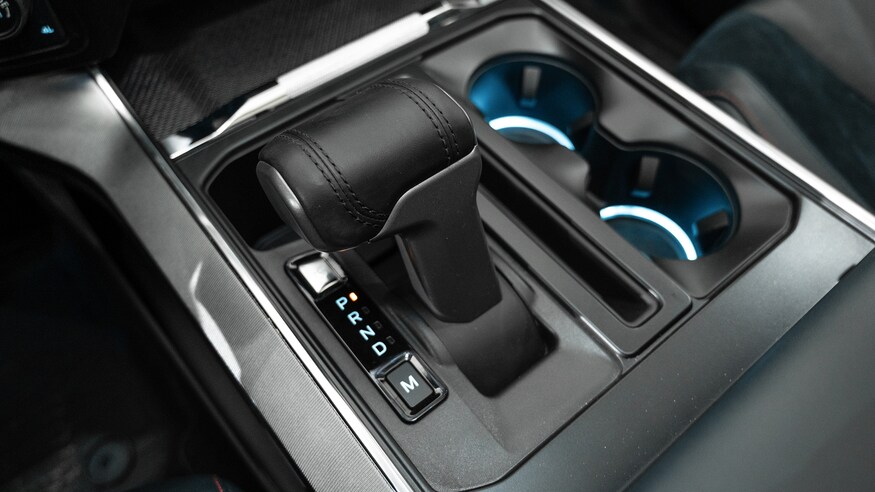2021 Ford F-150 Raptor Tech Highlights: Two Frames and a Trombone Exhaust
Inside the tech that makes the Raptor tick.
Ford's desert-race darling Raptor has offered two frames before, but that was to accommodate different cabs. Now offered in SuperCrew configuration only, the 2021 Ford F-150 Raptor gets a separate frame just to handle the beating it will take from the new Raptor 37 variant's Big Foot 37-inch tires when bounding off rocks and across arroyos. Let's examine the frames, the Live Valve Fox Shox, the "trombone exhaust," and other technical highlights that promise to make this third-generation Raptor the baddest of them all.
Two New Frames
All 2021 Raptor frames differ greatly from those of their lesser F-150 brethren to accommodate the longer-travel independent front and all-new five-link, coil-spring, live-axle rear suspension setups. In front are taller, stronger shock towers and a unique rear lower control arm pivot. At the rear, there are the control-arm mounting brackets, upper spring perches, and reinforced shock mounting locations
The Raptor 37 frame is further modified with reinforcements to areas like the rear jounce-bumper mounts to better withstand the forces generated by the massive and massively heavy 37-inch tires. And it's modified to accommodate a 37-inch spare tire. This involves altering a crossmember and the winch plate that lowers the spare. A different trailer hitch, bumper, and tow hooks were also required, but this structure is shared with the base Raptor.
Rear Suspension Details
Replacing the rear leaf springs Ford has equipped the F-Series with forever are a pair of trailing arms on each side, a set of 24-inch variable-rate coil springs, and a Panhard rod in back for lateral positioning. Before they're installed, those springs measure 0.4 inch taller than those on the Ram 1500 TRX, ranking them as the industry's longest. They feature variable taper and variable pitch to achieve three spring rates throughout the suspension's full range of travel. This setup saves 11 pounds of mass overall and reduces unsprung mass by an impressive 40 pounds.
Front Suspension Revisions
Increasing suspension travel means adding rebound travel. Up front, this required raising the upper control-arm mounts 0.4 inch and relying on new knuckles and control arms that locate the upper ball joint 0.7 inch higher and the lower ball joint slightly lower. The ball joints are also new, as are the front half-shaft inner CV joints, to allow for the more extreme angles experienced at full suspension droop.
Two New Sets Of Fox Shocks, Revised Live Valve Tech
This next generation of Fox shock provides double the compression control, which results in considerably higher internal forces. The tubes are made of thicker metal to handle the added stress. Inside, they feature nine zones of damping tune with internal bypass valving that varies with the position of the piston. The front shocks feature 1.0-inch-diameter piston shafts (up from 7/8-inch) and all utilize a new lower-friction shock fluid that better resists heat buildup. The range of authority of the electronically adjustable dampers is roughly doubled to provide upward of 1,000 pounds of damping per corner at desert speeds. Front and rear shocks all do their own sensing now (the rears used to take input from the fronts), and the damping rate can be changed in 80 milliseconds—the time it takes a human brain to process visual info. The Raptor 37 gets unique shocks tuned for the increased unsprung weight and revised travel.
Suspension Travel By The Numbers
Talk about the relentless march of progress—the world's first totally awesome factory desert racer, the 2010 Raptor, made do with a piddling 11.2 inches of front travel and 12.0 inches in the rear. The second-gen models bumped that up to 13.0 inches in front, 13.9 inches in rear travel, and for 2021, the base Raptor's front wheels arc through 14.0 inches of travel, while the rears can swing 15.0 inches. Interference issues with the larger 37-inch tires restrict their total travel to 13.0 inches in front, 14.1 in the rear on the Raptor 37. For those keeping score at home, the corresponding figures for the Raptor's lone new competitor, the 2021 MotorTrend Truck of the Year Ram 1500 TRX, are 13.0 and 14.0 inches, respectively.
Off-Road Clearance By The Numbers
Overall ground clearance, approach, breakover, and departure angles improve from the second-gen model's 11.5 inches and 30.2/21.8/23.0 degrees to 12.0 inches and 31.0/22.7/23.9 degrees with the base 35-inch tire, and to 13.1 inches and 33.1/24.4/24.9 degrees on 37s. Again, to save you Googling, TRX stats are 11.8 inches and 30.2/21.9/23.5 degrees.
Engine Tech And Trombone Exhaust
Scrutinizing the specs reveals that, for 2021, the 3.5-liter twin-turbo EcoBoost V-6 gets a compression-ratio bump from 10.0:1 to 10.5:1, a slight drop in coolant capacity (14.4 to 13.0 quarts), and an increase in alternator output from 220 to 240 amps. None of this is likely to alter the peak output figures much (emissions regulations drove much of that), but Ford is claiming improved low-end torque.
Raptor's trick new 3.0-inch-diameter exhaust system may yet pay off in a few added ponies (final calibration isn't expected for a few more weeks). The exhaust runs down the passenger side of the truck. This would cause exhaust from the driver-side bank to flow through a longer pipe, if not for a new "trombone loop" just aft of the engine compartment that equalizes these path lengths. The result is greatly improved sound. A new muffler with revised baffling and a bypass system also does wonders in this regard. Open the two valves in the pipes exiting the muffler fully for Baja drive mode, and the exhaust mostly short-circuits straight through the muffler, dumping into an X-shaped crossover pipe before exiting the dual tailpipes. Engaging quiet mode closes these valves, forcing the exhaust through all of the muffler's baffling and out a single pipe that rejoins that X-pipe. Two intermediate sound settings, normal and sport, split the difference between fully open and fully closed tailpipe valves.
Coil Suspension Yields Crisper Shifts, Quicker Sprints?
Call Ripley's; it's true. Leaf springs allow a live axle to "wind up," or twist slightly, as the tires deliver torque to the road. To minimize this effect, shifts have been slurred slightly in the past, but the upper and lower trailing arms on each side of the axle eliminate this phenomenon, so sport mode shifts can be sharper and crisper. Traction is also improved with this rear suspension, so even if the power, torque, and curb weight match the second-gen truck's, we can probably expect slightly quicker 0-60 mph times—not enough so to safely race TRXs for pink slips, mind you. That job will fall to the 2022 Ford F-150 Raptor R.
 Reviewed by Nemanja
on
February 06, 2021
Rating:
Reviewed by Nemanja
on
February 06, 2021
Rating:


















